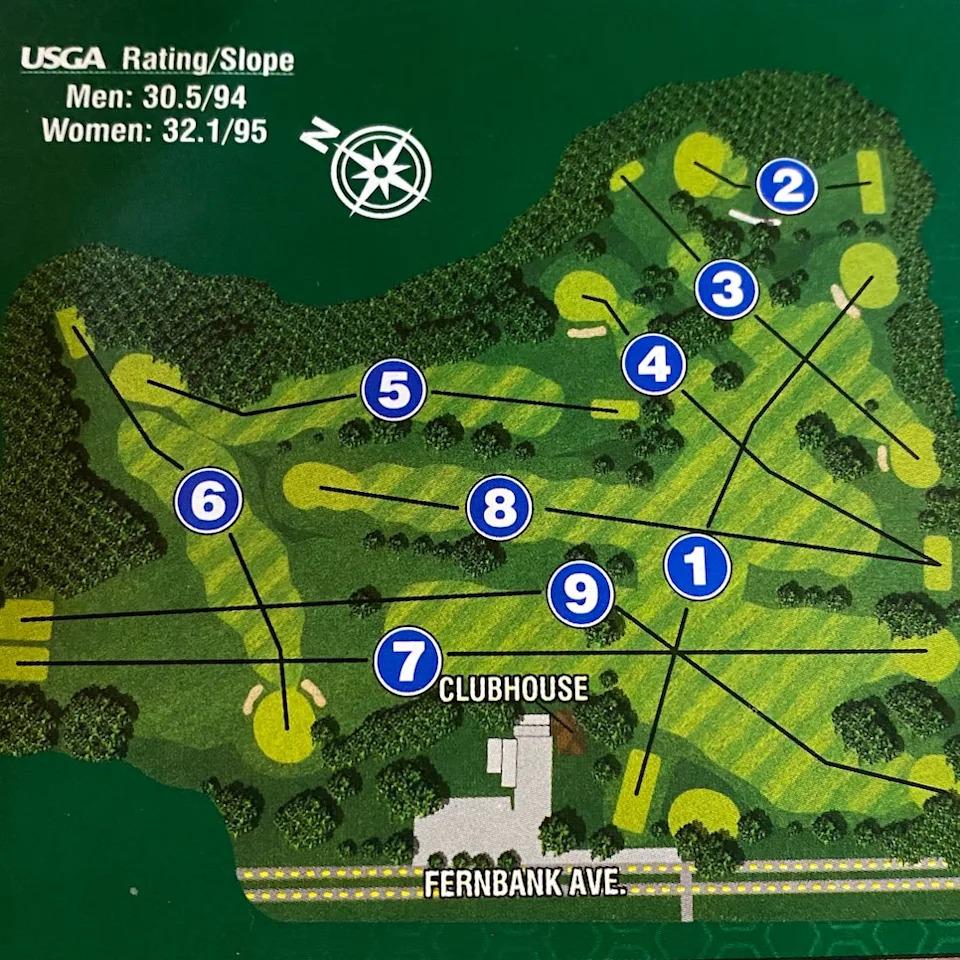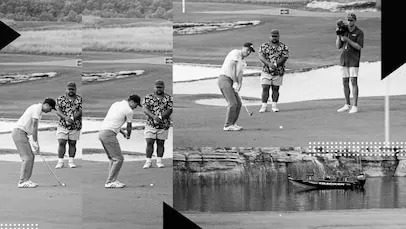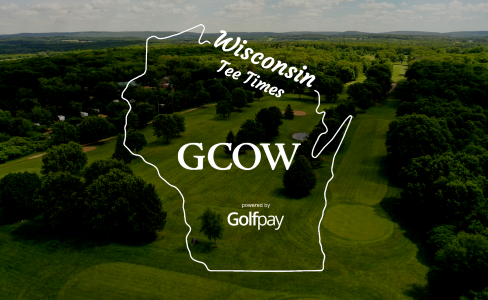It is Thanksgiving and I’m visiting family in Cincinnati, which means the worst golf hole in America is down the street. Fernbank Golf Course’s opener stretches 254 yards, a modest dogleg with a bunker stationed near the green. In isolation, it qualifies as the proverbial gentle handshake welcoming you to the round. But it’s not your hand you should be worrying about as much as your head, because the first intersects the ninth fairway.
And the seventh.
Along with the eighth.
Plus, the fourth.
We’d be remiss for failing to mention the third.
For those scoring at home, that’s five other holes crisscrossing a single opening tee shot, an architectural monstrosity that breeds slow play and concussions, which may explain why folks around here think putting chili on spaghetti constitutes culinary inspiration. The hole is, unobjectively, terrible. And that’s precisely what makes it transcendent.
Golfers tend toward pessimism, which is understandable. This is a game engineered for systematic humiliation, one that batters you into numbness, and sometimes the only available solace appears to be dwelling in the misery. What this overlooks is that golf’s most gratifying moments exist only because of the despair that made them possible in the first place. Without catastrophe, there’s no redemption; without enduring the game’s cruelties, there’s nothing worth overcoming. What’s bad is actually good.
Consider the driving range. The facility nearest to me offers balls that are predominantly battered, their aerodynamic integrity compromised by countless impacts whose imperfections are absurdly camouflaged by yellow spray paint that achieves the opposite of its intended purpose. The temptation is to lament the resulting trajectories, their doom ambiguous as to whether it resulted from flawed mechanics or using rocks as ammo. Yet there are always a few pristine balls scattered among the carnage, and when one materializes, your focus and purpose sharpen. You don’t want to squander this baby. Striking that ball exactly as envisioned, watching it climb and descend along its appointed arc, generates satisfaction equal to any flagged approach.
Or consider a disastrous opening sequence. We shouldn’t predicate enjoyment solely on score, but let’s acknowledge the truth: It feels good to play well. So all that anticipation and preparation, only to stumble through consecutive bogeys, can telegraph that the hours ahead will be an ordeal. But there exists a particular species of pride that accompanies resurrection. Anyone can maintain composure when circumstances cooperate; it requires gumption to go on from wreckage. And within that same paradox lives a peculiar liberation that accompanies a really bad start or hole. The dream of a career round evaporates, and with it any pressure you might feel, and suddenly you’re free to simply experience the journey unfolding before you.

/content/dam/images/golfdigest/fullset/2023/Fernbank.jpg
The interesting routing of Fernbank.
Bad weather? Recreational players see darks skies and flagsticks genuflecting violently, feel their clothes sticking to skin and reach for their car keys while asking for rain checks. Real golfers see the same storm and think, “Bring it on.” This isn’t an obstacle but invitation, nature’s way of separating the committed from the casual. The scorecard becomes irrelevant, for what matters now is endurance and adaptability. This is golf stripped to its essence, human will against natural chaos, a test not of skill refinement but of spirit.
Bad rounds can be a blessing. It makes us want to return, for redemption, sure, but also because it’s a pursuit we cannot quit. There is joy in the work and there is always labor required to reach where we aspire to go. Bad rounds from professionals offer instruction. A lesson that still resonates for me is watching Justin Thomas fail to break 80 in consecutive major championship rounds a few summers ago. JT had claimed a major less than a year prior, had devoted tens of thousands of hours to becoming among the world’s elite, was now rendered powerless. If it can happen to him, I realized, then there’s no hope for the rest of us … so perhaps grant yourself grace over that double bogey.
More From Golf Digest

Analysis How real is the possibility of a 20-event PGA Tour season? Let’s lay it out

Golf IQ The universal lessons from one golfer’s viral ‘nightmare’

Golf Digest Logo The Shot of His Life
Speaking of, bad language can serve a therapeutic purpose. Sometimes, when golf seems pathologically intent on testing your sanity and every bounce defies both physics and fairness, the healthiest and most honest response is simply releasing it in one explosive moment of cathartic liberation, letting the release valve blow before the accumulated frustration poisons the rest of your day. To go forward we have to mourn the injustice, progressing through righteous anger and accepted that this heartbreak is merely preparation for the next one lurking ahead.
Of course, limits exist, which is where bad etiquette intrudes. And that can also be a gift. Want to truly understand someone? Observe their demeanor on a golf course. That will reveal more about their character than any high-stakes boardroom or barstool conversation.
Bad putting can compel experimentation with new putters. Perhaps you discover one that alters your fortunes, or you realize the fault lay not with the implement but the operator, and you return to your trusted flatstick with newfound appreciation, pledging fidelity and gratitude for what you possess (at least until the next three-putt). No one anticipates a bad random pairing with enthusiasm … yet how often do those awkward pairings generate the most memorable stories? Bad style always provides entertainment. Bad lies frequently present opportunities for heroism—even bad lies in fairway divot holes, which remains a bad rule, regardless of how many of you consider that a bad take.
There’s no such thing as a bad day on the course, a bad halfway house hot dog, a bad buddies’ trip, because some experiences are impervious to cruelty. But some elements remain unequivocally bad without redemptive spin. Glacial pace of play, bad-faith actors in the professional game more concerned with themselves than what they’re doing to the game, dishonest handicaps of both sandbagging and vanity varieties. And there’s no escaping the reality that sometimes genuinely bad things will occur. When the bad arrives, there is the necessary moment to be angry, wounded, despondent, and it may feel like misfortune has become your permanent condition.
But these moments can awaken you to all the good you’ve been taking for granted. They clarify what matters, separating the grievances that occupy too much mental real estate. Sometimes you need the worst rounds to fully appreciate the merely mediocre ones, to recognize that showing up at all is its own triumph, that what you have is not entitlement but luxury. It reveals what endures when everything else falls way.
Which brings us back to Fernbank. It’s only $15 to walk, half that for juniors. It’s a layout that’s welcoming to beginners but challenging enough for vets, and always fun. The property sits in the middle of a blue-collar neighborhood and takes it location to heart; the clubhouse serves as the de facto town hall, people walk their dogs on the course without fuss and there’s a music series on the lawn in the summer. It’s one of the few remaining public courses on this side of town. The course is an agent of good. That includes the chaotic first hole. In a sport often characterized by monotonous similarity, there’s something valuable about an anomaly this pronounced. Plus, you’d be astonished how many lost balls you recover when six holes converge on a single fairway.
So this Thanksgiving, be grateful for the many hardships of this beautifully stupid game. Even when golf is at its worst, it remains the best.







